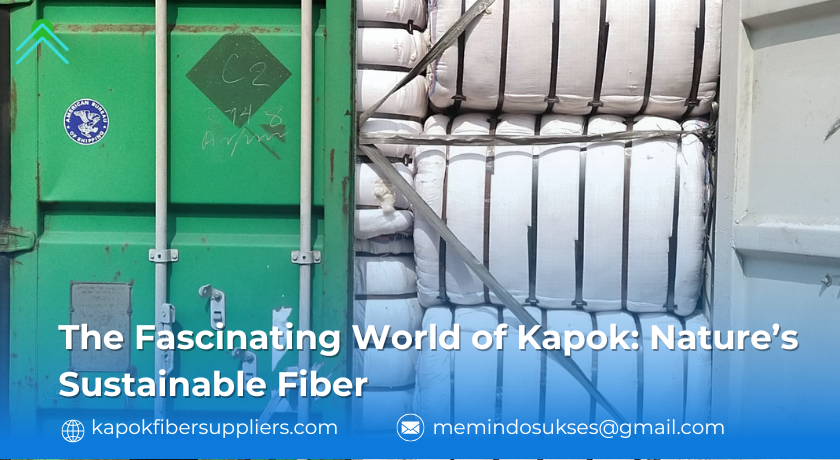
The Fascinating World of Kapok: Nature’s Sustainable Fiber
Kapok, often overshadowed by more common natural fibers like cotton or silk, is an incredible resource that deserves attention. With its lightweight and sustainable qualities, kapok is gaining popularity as a natural alternative in various industries. Derived from the kapok tree (Ceiba pentandra), this fiber has been used for centuries, especially in tropical regions. In this article, we’ll explore everything you need to know about kapok, its history, benefits, and how it’s making waves in the world of sustainability.
What is Kapok?
Kapok is a soft, silky fiber that grows inside the pods of the kapok tree. This tree, which thrives in tropical climates across Southeast Asia, Central America, and parts of Africa, produces large, fluffy pods that contain the kapok fibers. These fibers are lightweight, buoyant, and incredibly durable, which is why they have found use in a variety of applications, from traditional mattresses to modern eco-friendly products.
The kapok tree produces a fruit that is similar in appearance to a coconut, but inside, you’ll find thousands of tiny fibers that surround the seeds. These fibers, after being harvested and processed, become a natural alternative to synthetic materials.
The History of Kapok
Kapok has a long and fascinating history. Indigenous people of the Americas and Southeast Asia have utilized the kapok tree for thousands of years. Historically, kapok fiber was used in traditional mattresses and pillows due to its softness and lightness. In fact, before the advent of synthetic materials like foam, kapok was a key component of many luxury mattresses and cushions.
Moreover, kapok has been essential in traditional medicine. Various parts of the kapok tree, including the leaves, bark, and seeds, have been used for their medicinal properties. The tree’s ability to grow rapidly and thrive in diverse conditions made it a staple resource in tropical communities.
Unique Features of Kapok
Kapok possesses several unique features that set it apart from other fibers:
- Lightweight and Buoyant: Kapok’s fibers are exceptionally light and have a natural buoyancy. This made it ideal for use in life vests and flotation devices in the early 20th century. Its buoyancy is due to the structure of the fiber, which is hollow and filled with air.
- Sustainability: As a natural product, kapok is biodegradable and eco-friendly. Unlike synthetic fibers, which can take hundreds of years to decompose, kapok breaks down quickly in the environment, leaving behind no harmful waste. The kapok tree is also a fast-growing plant, which makes it a renewable resource.
- Hypoallergenic Properties: Kapok fibers are naturally resistant to dust mites and other allergens, making them an excellent choice for people with allergies or respiratory issues.
- Durability: Kapok fibers are known for their resilience. Although they are light, they are also strong, which gives them an extended lifespan in products like mattresses and pillows.
- Water Resistance: The hollow structure of kapok fibers also makes them water-resistant. This quality has historically made them ideal for water-related applications such as life vests, cushions, and even insulation for boats.
The Role of Kapok in Sustainable Products
In recent years, sustainability has become a central focus in many industries, and kapok is stepping into the spotlight as a sustainable material. Several companies are now using kapok in eco-friendly products, particularly in the textile, furniture, and bedding industries.
Kapok in Mattresses and Cushions
One of the most common uses of kapok today is in organic mattresses and cushions. Traditional mattresses often contain synthetic foams, which can be harmful to the environment. Kapok, however, is 100% natural, biodegradable, and free from toxic chemicals. This makes it a perfect alternative for eco-conscious consumers looking to reduce their carbon footprint.
Kapok in Clothing and Accessories
Fashion brands are starting to use kapok as an alternative to synthetic fibers, especially in jackets, blankets, and other insulated products. The fiber’s lightness and warmth make it an ideal material for high-performance outerwear. Furthermore, as consumers become more environmentally aware, the demand for sustainable clothing materials is on the rise, which has contributed to the popularity of kapok.
Kapok in Insulation
Kapok is also gaining attention in the field of insulation. Companies are exploring its use as a sustainable alternative to traditional insulation materials, such as fiberglass or foam. Its lightness, insulation properties, and biodegradability make it a promising material for building insulation, particularly in eco-friendly homes.
The Environmental Impact of Kapok
Kapok’s environmental benefits are hard to ignore. The kapok tree is a vital part of the ecosystem, supporting local wildlife by providing habitat and food. Moreover, it helps prevent soil erosion in tropical regions, playing an essential role in maintaining the health of the ecosystem.
The fiber’s production process is also eco-friendly. Unlike synthetic fibers, which require energy-intensive manufacturing processes and the use of harmful chemicals, kapok is harvested from the tree and processed with minimal environmental impact. This makes it a much greener option when compared to alternatives.
The Future of Kapok
As the world shifts towards more sustainable and eco-conscious practices, kapok’s future is looking bright. Innovations in the use of kapok fiber are expected to expand as more industries recognize the benefits of this remarkable natural material. From biodegradable packaging to eco-friendly insulation, kapok is on the path to becoming a leading material in the fight against environmental degradation.
Conclusion
Kapok is a versatile and eco-friendly material with an impressive range of applications. From its history as a flotation device to its modern-day role in sustainable products, this remarkable fiber is poised to become a key player in the world of green innovation. With its lightweight, durable, and biodegradable qualities, kapok presents a solution to the growing demand for sustainable alternatives in various industries. As we continue to focus on sustainability, kapok might just be the natural resource that helps us build a more eco-conscious future.

